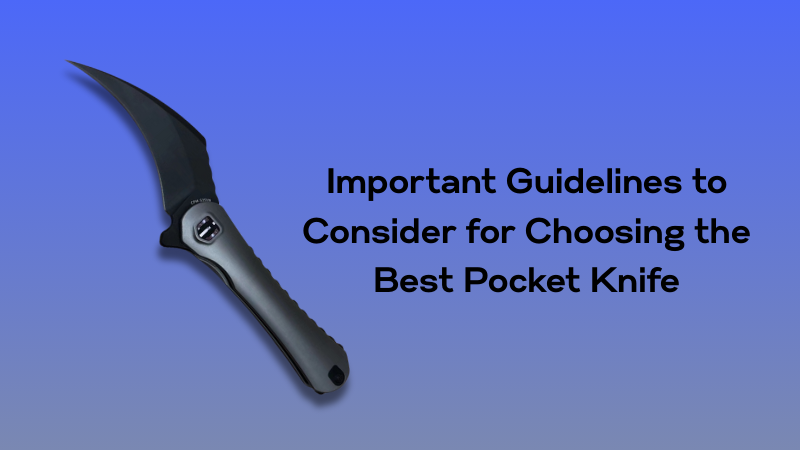
Important Guidelines for Choosing the Best Pocket Knife

When it comes to essential everyday tools, few items are as practical and versatile as a Pocket knife. Compact, functional, and easy to carry, a Folding Knife can serve
countless purposes — from opening packages to performing survival tasks in the wild.
At Shieldon, where craftsmanship meets innovation, we understand how vital it is to select the right knife for your needs. With so many options available, choosing the best Pocket knife might seem overwhelming, especially for beginners. To help you make the right choice, we’ve outlined the key factors you should consider.
How Many Blades Do You Need?
One of the first decisions you’ll need to make is whether you want a single-blade knife, a multi-blade knife, or a multi-tool design.
Single-Blade Pocket Knives
Single-blade knives are simple yet powerful. They typically offer a strong, durable blade that locks securely into place, making them ideal for everyday tasks. If you prefer a knife that is easy to maintain and highly reliable, a single-blade Shieldon knife might be your perfect match.
Multi-Blade Pocket Knives
Multi-blade knives feature two to four blades within one compact frame. Each blade type serves a different purpose—clip point for precision, drop point for general use, and more. While multi-blade knives offer versatility, they may sacrifice some strength compared to single-blade designs.
Multi-Tools
For those who need more than just a blade, multi-tools provide additional functionalities like screwdrivers, can openers, scissors, and nail files. Though slightly heavier, they are incredibly handy for camping, hiking, or daily repairs. Consider a multi-tool EDC knife if you value having multiple tools at your fingertips.
Choosing the Right Blade Edge
The edge style of your Pocket knife greatly influences its performance.
Plain Edge
A plain edge offers clean, precise cuts, ideal for push-cut tasks like slicing fruits or carving wood. It's easy to sharpen and perfect for users who need precision over aggression.
Partially Serrated Edge
Combining a smooth edge with a serrated section, partially serrated knives provide flexibility for cutting through tougher materials like rope, while still allowing for fine work.
Fully Serrated Edge
Best for sawing through hard, fibrous materials, fully serrated knives maximize cutting efficiency. However, they are harder to sharpen and less suited for clean slicing.
Choosing the correct blade edge depends on your intended use, whether it’s daily carry, outdoor adventures, or specialized activities like martial arts where a tactical edge might be crucial.
What Blade Size Fits Your Needs?
Blade size impacts the knife’s portability and functionality.
· Small Blades (Under 2.75 inches):
Perfect for discreet everyday carry. They comply with most knife laws and handle basic tasks easily.
· Medium Blades (2.75 to 4 inches):
A great balance between portability and capability, suitable for heavier EDC tasks without being cumbersome.
· Large Blades (Over 4 inches):
Powerful and closer to fixed-blade functionality. While great for heavy-duty use or self-defense, larger Pocket knives are less ideal for everyday urban carry.
Blade and Handle Materials
Blade Materials
Stainless steel remains the go-to choice for most high-quality Pocket knives, offering a balance of corrosion resistance, strength, and ease of maintenance. Variants like 440C steel prioritize rust resistance, while CPM 3V steel provides superior toughness — materials we proudly use in the crafting of a Shieldon knife.
Handle Materials
The handle contributes to the knife’s grip and durability. Common choices include:
· Aluminum: Lightweight and corrosion-resistant.
· G10: Extremely tough fiberglass composite.
· Titanium: High strength-to-weight ratio.
· Micarta and Zytel: Durable synthetics known for their lightweight ruggedness.
Shieldon knives utilize a variety of these premium materials to ensure performance and comfort in all conditions.
Understanding Opening and Locking Mechanisms
Opening and securing your knife efficiently is crucial, especially for EDC purposes.
Opening Mechanisms
· Manual Opening:
Utilizes thumb studs or nail nicks to open the blade manually. Traditional but reliable.
· Assisted Opening:
Blades deploy quickly with minimal effort once initiated, combining manual control with speed.
· Automatic (Switchblade):
A button or switch instantly releases the blade. Ideal for emergency situations but often restricted by law.
Locking Systems
Reliable locking prevents accidental closure during use. Common types include liner locks, frame locks, lockbacks, and ring locks. At Shieldon, precision locking mechanisms are standard in our EDC and Martial Arts knives to maximize user safety.

Takeaways: Find Your Perfect Pocket Knife
Choosing the right Pocket knife comes down to understanding your specific needs:
· Daily Use: Go for a medium-sized EDC knife with a simple locking mechanism.
· Outdoor Survival: Consider a larger folding blade with a partially serrated edge.
· Self-Defense or Martial Arts: Prioritize quick deployment and secure locking systems.
At Shieldon, we offer a wide range of knives tailored to every application—from sleek urban EDC designs to rugged tactical models ideal for outdoor or martial arts use. Whether you're selecting your first folding knife or adding another masterpiece to your collection, we have a knife that fits your lifestyle.
For more tips, product showcases, and weekly updates, subscribe to Shieldon channels and explore our world-class collection today.
